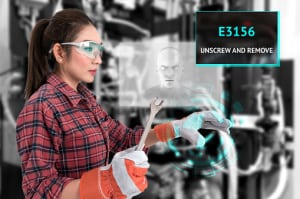If you haven’t already started, don’t be left behind. Follow these three steps to begin the process
“Digital” is a pretty popular term today, used to describe nearly anything online, on a computer or related to any disruption facing an industry. Digital transformation is happening so much now that it has almost lost its meaning and impact. But, that doesn’t mean it isn’t an important concept.
As an industrial organization, you likely have already established your digital transformation strategy. According to a recent McKinsey article, industrial companies can cut the cost to serve their customers by 50–70% [1] – certainly a significant figure worthy of consideration. Other opportunities exist to better extend the life of production assets, reduce downtime and better serve increasingly diversified and geographically distributed customers.
From speaking with the industrial companies I work with, I can tell you one of the frequent challenges I encounter is, “How do I get started?” With so many options, what do you do first?
Most of the people I speak with understand now is the time to act, but picking that first step can be difficult. Two reasons come to mind. First, starting a new project is difficult; often an executive sponsor is needed. Implementing a digital transformation strategy may not be at the top of everyone’s mind. Second, with considerable “unknowns” when starting a new project, especially one with such broad visibility across an organization, few are willing to “bet their career” on a new project. The value proposition needs to be quite compelling, with a significant upside, return on investment and a high likelihood for significant success.
The first step to getting started
Companies in the chemical process industries (CPI) face many pressures today. Increasing inflation rates around the world are driving up the price of raw materials and squeezing profit margins. Growing regulatory pressure from national and international governing bodies has increased the cost and complexity of compliance. At the same time, an aging and retiring workforce makes knowledge retention critical.
In this market, chemicals manufacturers seeking to overcome these challenges are experiencing success by gaining competitive advantage and achieving a higher return on investment by investing in new digital technologies, including those related to the industrial internet of things (IIoT).
Therein lies my first suggestion: closely tie your digital transformation initiative to addressing one of these top challenges. This ensures your resources are being optimized to reap the biggest reward, helping you to gain executive support and sponsorship to move your digital plan through all the necessary approvals.
Crawl, walk, run
My next suggestion is to pick a couple of smaller projects that can be started and implemented relatively quickly to show a fast return on investment. These types of projects are great to validate that your strategy is right on, and to show that it doesn’t take a massive project to demonstrate the power of applying digital transformation to your business model.
Upon achieving success in your first projects, it should come as no surprise that future approvals will follow suit, and in progressively larger scope. Risk of failure or under-delivering on promises becomes steadily reduced. Cost savings and process efficiency can then help ensure a steady pipeline of new projects, creating a nice cycle whereby performance improvement and productivity gains accelerate. You might be a bit more busy preparing new process improvement projects, but perhaps that’s not such a bad problem to have?
‘Bite-size’ projects to start the transformation
Here are three projects to choose from that can help you to get your first “crawl” step started, as part of your digital transformation journey. I have been part of the teams that implemented these programs at a variety of chemicals and other CPI companies. They work. The investment of time, effort and resources is reasonable, so the approval process can be simplified and streamlined.
Here are the top three projects where I have seen the greatest success:
- Digital transformation of work processes
- Augmented/mixed reality for operations and maintenance
- Predictive asset analytics
These types of projects can deliver value in a timeline of weeks or months, not years. And, the return on investment can be quite significant. As just two examples, chemicals companies that the author’s employer has worked with have seen the following benefits from these types of implementations:
- $500,000 saved in a single predictive maintenance catch
- Over $1 million saved in maintenance costs by implementing mobile operator rounds
These technologies solve real, practical business problems. What if you could automate, digitize and share best practices across your entire workforce? What if you could visualize an entire asset’s operational history as you conducted maintenance on it? What if you could catch problems days, weeks or months before they occur? By delivering on these promises, these use cases deliver much more value than a fancy talking hologram display or a flashy marketing deck.
Let’s take a closer look at these three examples, to explore what value is possible.
Digital transformation of work processes. Every production cycle can be viewed as a collection of processes. In a perfect world, everything works the first time, all plans come true and no surprises exist. Of course, that world doesn’t exist. The real world of production scheduling has surprises and adjustments that must be made.
Many of the organizations I speak with have some sort of manual or paper-based process for planning or scheduling. This is one example of a process that could be digitalized to make a big, quick impact on productivity. A pilot project could be started to digitalize these processes at one location, to then compare performance to others or to a baseline, for a quick demonstration of the value of digitizing a work process.
Another area to look for a quick win is in the mobile world. The number of mobile devices in the world has exploded — according to Pew, 77% of Americans now own a smartphone, up from 35% in 2011 [2]. Similar growth trends are in evidence across the world.
Worker expectations have shifted to now wanting to do their job on a mobile device. Those tasked with operator rounds have a compelling case. CPI companies can take advantage of this cultural transformation by implementing mobile operator rounds on specialized rugged tablets designed for operation in hazardous environment. This transition is even easier for chemicals companies that operate in environments where it is suitable for bring your own device (BYOD) policies. Nearly every employee now has a powerful personal computer in their pocket — one that they might even be willing to purchase — that could be used to improve accuracy and data collection with your mobile operator rounds.
With mobile operator rounds, it is possible for companies to fundamentally transform the very way they do work. Operators can be guided to adhere with best practices wherever they are in the field, ensuring asset operations and maintenance is optimized across the entire business. These solutions also capture stranded data, improving operational visibility. Integration with automated workflows and enterprise asset management (EAM) systems make conducting maintenance as efficient and accurate as possible. For example, when Ascend Performance Materials LLC (Houston; www.ascendmaterials.com) implemented a digital mobile operator rounds solution, the company saved over $1 million in reduced maintenance costs [3].
Augmented/mixed reality for operations and maintenance. In contrast to converting manual or paper-based mobile operator rounds to the digital world, the realm of augmented (AR) and virtual reality (VR) started its life as a digital technology. These technologies emerged into the public consciousness with the Pokémon Go craze of just a couple of years ago. Today, it is in the maintenance world where this technology is showing its full value.
Industrial chemicals companies are now deploying mixed reality (MR) solutions — using both AR and VR together — to empower field operators with intelligence, directive procedures and actionable commands. Maintenance instructions and intelligent support can optimize how these activities are managed, and how process improvement can be executed in near realtime.
MR solutions make it possible for operators to visualize an asset’s entire operational history, along with realtime and historical data, directly on screen as they conduct operations and maintenance. These types of solutions can be added as a new “layer” to support existing paper-based manuals or processes. Soon, it will be apparent from the cost savings and productivity improvement that paper-based manuals can be eliminated.
Integration with advanced engineering simulations lets operators visualize an asset and what potential issues might exist that triggered a maintenance order. This gives valuable context to the operator, enabling maintenance processes to be done with greater effectiveness — including for someone who is new to the process, such as a “millennial” new hire.
If a future problem occurs that can’t be readily understood, instant video-conferencing capabilities are now possible — the “call a friend” option — to share what the operator is seeing, and to share the diagnostic process to remedy the situation. Staffed through off-site subject matter experts, this type of maintenance escalation process scales nicely across multiple locations.
BASF SE (Ludwigshafen, Germany; www.basf.com) is an industry leader now relying upon AR as a key pillar of its digital transformation strategy. BASF’s decision to digitally transform how these work practices are performed was likely based on significant due diligence and with a cost-benefit analysis to justify its investment. If it makes sense for it to invest in this type of program, so too might it be for you.
Predictive asset analytics. The third area where I’ve seen the most “quick wins” from a pilot or other introductory project is in the category of predictive asset analytics. Amazing savings are not only possible, but readily available (and cost-effective) under the header of machine learning, advanced pattern recognition and artificial intelligence.
Predictive maintenance solutions are one such example that use these advanced analytics techniques to predict problems before they occur. Once an issue is identified, built-in fault diagnostics make it possible to conduct a root cause analysis to determine the true source of the issue. Early warnings and advanced workflows allow operators to address the source of the problem quickly and efficiently. By doing so, predictive maintenance can then allow chemicals companies to reduce unscheduled downtime, improve asset reliability and performance and decrease maintenance costs. One large producer of industrial gases saved over $500,000 on a single predictive maintenance catch.
Predictive maintenance can be deployed either on- or off-site, so it can be outsourced or performed in-house. This means there are many options available, each offering different advantages based on your organization and how quickly you would like to proceed. With this many options, picking a first starter project in this area could be a nice early “win” for your digital transformation strategy. Regardless how you staff this type of project, these services empower companies to leverage predictive maintenance and the expertise of a team of experts, while reducing total cost of ownership.
Concluding remarks
Any of these use cases can be deployed individually, together or in whatever priority order that makes the most sense to your organization. Each can deliver a quick ROI, a return that can likely be achieved in the same calendar year. More importantly, these digital technologies are real, proven and now in actual use by industrial organizations. Each can serve as a valuable gateway to unlock greater, more holistic digital strategies that can be implemented across your enterprise.
These programs can drive even greater value from existing investments, to improve decision support and your overall organization’s strategic direction forward. Further, this digital transformation enables chemicals companies to develop more agile business models, improve regulatory compliance and raise the bar on what the industry deems as the benchmark for operational excellence, helping you to put a little pressure on your competitors instead of the other way around.
References
2. www.pewinternet.org/fact-sheet/mobile.
3. https://sw.aveva.com/news/operational-excellence-at-empowering-mobile-workforce-event
Author
 Justin Thomas Pivec is a business development manager at AVEVA (High Cross, Madingley Road, Cambridge CB3 OHB, U.K.; Email: [email protected]). Pivec is currently leading the growth strategies in APAC, Middle East, North Africa, and Latin America for the company’s enterprise asset-performance-management portfolio. He has 20 years of experience providing technology solutions to industrial companies across the world and is Aveva’s predictive asset-health-monitoring expert. Previously Pivec was the general manager for InStep Software in Beijing and a regional marketing manager for Siemens in Canada. His experience includes international business development, account management and industry consulting. Pivec earned a B.S.M.E. from Lafayette College and a M.B.A. from DePaul University.
Justin Thomas Pivec is a business development manager at AVEVA (High Cross, Madingley Road, Cambridge CB3 OHB, U.K.; Email: [email protected]). Pivec is currently leading the growth strategies in APAC, Middle East, North Africa, and Latin America for the company’s enterprise asset-performance-management portfolio. He has 20 years of experience providing technology solutions to industrial companies across the world and is Aveva’s predictive asset-health-monitoring expert. Previously Pivec was the general manager for InStep Software in Beijing and a regional marketing manager for Siemens in Canada. His experience includes international business development, account management and industry consulting. Pivec earned a B.S.M.E. from Lafayette College and a M.B.A. from DePaul University.
